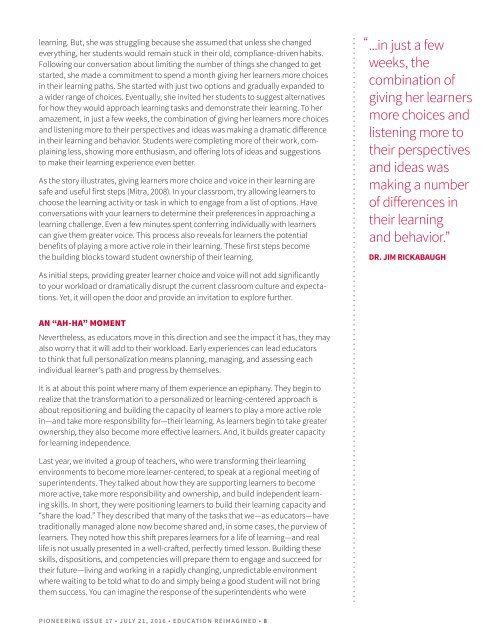pioneering
GUOH302uhdw
GUOH302uhdw
Create successful ePaper yourself
Turn your PDF publications into a flip-book with our unique Google optimized e-Paper software.
learning. But, she was struggling because she assumed that unless she changed<br />
everything, her students would remain stuck in their old, compliance-driven habits.<br />
Following our conversation about limiting the number of things she changed to get<br />
started, she made a commitment to spend a month giving her learners more choices<br />
in their learning paths. She started with just two options and gradually expanded to<br />
a wider range of choices. Eventually, she invited her students to suggest alternatives<br />
for how they would approach learning tasks and demonstrate their learning. To her<br />
amazement, in just a few weeks, the combination of giving her learners more choices<br />
and listening more to their perspectives and ideas was making a dramatic difference<br />
in their learning and behavior. Students were completing more of their work, complaining<br />
less, showing more enthusiasm, and offering lots of ideas and suggestions<br />
to make their learning experience even better.<br />
As the story illustrates, giving learners more choice and voice in their learning are<br />
safe and useful first steps (Mitra, 2008). In your classroom, try allowing learners to<br />
choose the learning activity or task in which to engage from a list of options. Have<br />
conversations with your learners to determine their preferences in approaching a<br />
learning challenge. Even a few minutes spent conferring individually with learners<br />
can give them greater voice. This process also reveals for learners the potential<br />
benefits of playing a more active role in their learning. These first steps become<br />
the building blocks toward student ownership of their learning.<br />
“...in<br />
just a few<br />
weeks, the<br />
combination of<br />
giving her learners<br />
more choices and<br />
listening more to<br />
their perspectives<br />
and ideas was<br />
making a number<br />
of differences in<br />
their learning<br />
and behavior.”<br />
DR. JIM RICKABAUGH<br />
As initial steps, providing greater learner choice and voice will not add significantly<br />
to your workload or dramatically disrupt the current classroom culture and expectations.<br />
Yet, it will open the door and provide an invitation to explore further.<br />
AN “AH-HA” MOMENT<br />
Nevertheless, as educators move in this direction and see the impact it has, they may<br />
also worry that it will add to their workload. Early experiences can lead educators<br />
to think that full personalization means planning, managing, and assessing each<br />
individual learner’s path and progress by themselves.<br />
It is at about this point where many of them experience an epiphany. They begin to<br />
realize that the transformation to a personalized or learning-centered approach is<br />
about repositioning and building the capacity of learners to play a more active role<br />
in—and take more responsibility for—their learning. As learners begin to take greater<br />
ownership, they also become more effective learners. And, it builds greater capacity<br />
for learning independence.<br />
Last year, we invited a group of teachers, who were transforming their learning<br />
environments to become more learner-centered, to speak at a regional meeting of<br />
superintendents. They talked about how they are supporting learners to become<br />
more active, take more responsibility and ownership, and build independent learning<br />
skills. In short, they were positioning learners to build their learning capacity and<br />
“share the load.” They described that many of the tasks that we—as educators—have<br />
traditionally managed alone now become shared and, in some cases, the purview of<br />
learners. They noted how this shift prepares learners for a life of learning—and real<br />
life is not usually presented in a well-crafted, perfectly timed lesson. Building these<br />
skills, dispositions, and competencies will prepare them to engage and succeed for<br />
their future—living and working in a rapidly changing, unpredictable environment<br />
where waiting to be told what to do and simply being a good student will not bring<br />
them success. You can imagine the response of the superintendents who were<br />
PIONEERING ISSUE 17 • JULY 21, 2016 • EDUCATION REIMAGINED • 8


